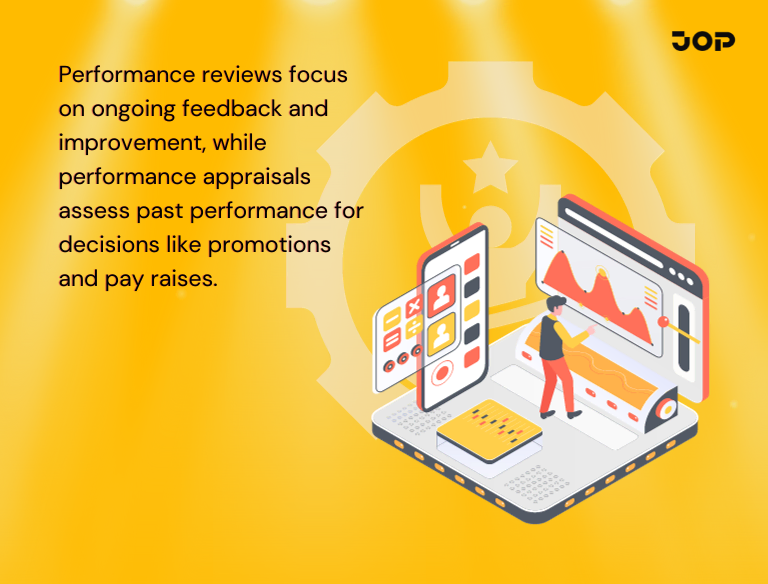What is the purpose of performance reviews and appraisals? can either be your ticket to professional growth or the dreaded annual event that sends shivers down your spine.
If you’re one of the many who find these evaluations more of a headache than a helpful tool, you’re not alone.
The problem? Most of us haven’t been trained to give fair, constructive reviews. It’s like being thrown into the pool’s deep end without knowing how to swim.
And the fear of feedback, whether you’re on the giving or receiving end, can make the whole process feel like a high-stakes game with your career hanging in the balance.
But worry not because, in this blog, we’re not just going to tell you what they are.
We’ll tell you the purpose of performance reviews and appraisals and how you can use them to your advantage.

What is the Purpose of Performance Reviews and Appraisals?
Performance reviews serve as a valuable tool for employees and their managers to have open and constructive conversations about job performance.
Their main purpose is to provide feedback, set expectations, and align goals. By discussing strengths and improvement areas, performance reviews help employees understand how their work contributes to the company’s success and how they can grow in their roles.
Additionally, they promote effective communication, boost employee morale, and support career development by identifying training and advancement opportunities.
Ultimately, it aims to enhance job satisfaction, align individual efforts with organizational goals, and improve overall team and company performance.
What is the Purpose of Performance Appraisals?
What is performance appraisals, often conducted annually, are a structured evaluation process that assesses employees’ work over a specific period.
Their primary purpose is to determine how well employees have met their job responsibilities and performance expectations.
It helps HR and Managers make compensation, promotions, and job assignment decisions. They also provide a formal record of an employee’s accomplishments and areas needing improvement.
The goal of performance appraisals is to fairly and accurately evaluate employee performance, recognize achievements, identify developmental needs, and ensure that compensation and career progression are based on merit and align with the organization’s goals.
The Purpose of Performance Reviews from the Employee’s Perspective
Performance reviews can be a source of both anticipation and anxiety for employees, as they provide a crucial opportunity to discuss their work, growth, and future within the company.
Concerns
First and foremost, they may worry about how their work is perceived. Are they meeting their company’s expectations? Have they made any mistakes that could affect their performance rating?
They also fear that their accomplishments might not receive the recognition they deserve. Additionally, the thought of constructive criticism can be daunting – they hope for feedback that helps us improve without feeling demoralized.
Expectations
On the flip side, they enter performance reviews with high hopes. They expect clarity about their roles and responsibilities, a chance to discuss their career aspirations, and an understanding of how their contributions fit into the bigger picture.
They want a fair evaluation of their performance and an opportunity to set meaningful goals for the future. Most importantly, they expect their managers to listen actively, acknowledge their efforts, and provide support where needed.
Recent Developments and Trends
In recent years, there has been a shift towards more frequent and informal check-ins between employees and managers rather than relying solely on annual performance reviews.
This trend aligns with the desire for real-time feedback and ongoing dialogue, which they usually manage on a common performance tracking software.
Additionally, many organizations emphasize employee development and growth during performance reviews, moving away from a purely evaluative approach.
The Purpose of Performance Appraisals from the Employee Perspective
Concerns
One of their primary concerns revolves around the fairness and objectivity of the appraisal process. Employees worry that their efforts may not be accurately reflected or that subjective biases might influence the evaluation.
The fear of receiving negative feedback or a lower rating can also create anxiety. Additionally, there’s often uncertainty about the consequences of the appraisal, such as its impact on promotions, raises, or job security.
Expectations
From performance appraisals, employees expect transparency and clarity. They want a clear understanding of the criteria and metrics used to evaluate their work.
It’s important for them to have an opportunity to discuss their accomplishments, challenges, and career aspirations with their managers. Sometimes, they may even look for supporting resources like a recommendation letter template when exploring growth opportunities or preparing for career transitions. They also hope for constructive feedback that helps them grow and develop professionally.
Furthermore, they expect the appraisal process to be a two-way conversation, where their input is valued and where they can set realistic goals for their future performance.
Recent Developments and Trends
In recent years, there has been a noticeable shift towards more frequent and continuous feedback, which aligns with the desire for ongoing communication between employees and managers.
Many organizations are moving away from the traditional annual performance appraisal model and embracing approaches that emphasize real-time coaching and development.
Additionally, companies are increasingly emphasizing a holistic view of performance, considering not only an employee’s individual contributions but also their alignment with the company’s values and goals.
Why are Performance Reviews More Beneficial than Performance Appraisals?
Performance reviews emphasize continuous feedback, development, engagement, alignment with goals, data-driven decisions, adaptability, and ethical considerations, making them more vital in today’s workplace than traditional appraisals.
- Continuous feedback vs. Annual assessment: Reviews offer real-time feedback, while appraisals are often annual and retrospective.
- Employee development: Reviews focus on growth and skill enhancement, whereas appraisals can be punitive.
- Employee engagement: Reviews foster engagement, while appraisals can lead to disengagement.
- Alignment with organizational goals: Reviews ensure individual goals align with the company’s objectives.
- Data-driven decisions: Reviews incorporate data for objective assessments and targeted development.
- Adaptation to modern workforce trends: Reviews suit today’s workforce’s need for frequent communication and improvement.
- Legal and ethical considerations: Reviews promote fairness, transparency, and ethical behavior.
Manager’s Role in Performance Reviews and Appraisals
Performance Reviews
Performance reviews are a crucial aspect of managing a team and can greatly impact an organization’s success. Here’s a detailed overview of the manager’s role in performance reviews:
- Setting expectations: Define clear performance expectations, roles, and KPIs for each team member.
- Regular feedback: Provide ongoing feedback for employee engagement and improvement.
- Goal setting: Collaborate on SMART goals aligned with organizational objectives.
- Performance metrics: Use data analytics for accurate performance measurement.
- Review preparation: Gather feedback from various sources, not just manager input.
- Conducting reviews: Offer constructive feedback, listen to employees, and discuss development.
- Development plans: Create action plans to improve performance and achieve career goals.
- Recognition and rewards: Acknowledge exceptional performance through various incentives.
Performance Appraisals
- Goal setting: Collaborate with employees to set clear and measurable performance goals aligned with the organization’s objectives.
- Regular feedback: Provide ongoing feedback to help employees understand their strengths and areas needing improvement.
- Performance documentation: Maintain records of employee performance, including achievements and areas for improvement.
- Conducting appraisals: Schedule formal performance appraisal meetings to discuss progress and goal attainment.
- Performance ratings: Assign fair and objective ratings based on well-defined criteria, moving away from traditional ratings where possible.
- Development planning: Create development plans with employees to address skill gaps and career aspirations.
- Recognition and rewards: Recognize and reward outstanding performance, fostering motivation and engagement.
- Follow-up: Monitor progress on action plans and provide continuous support to help employees meet their goals.
Manager’s Role in Continuous Performance Management
Why are Continuous Performance Management or Reviews More Critical than Performance Appraisals?
Unlike annual or periodic reviews, continuous performance management offers ongoing feedback and communication between managers and employees.
This approach is more agile and responsive to the dynamic nature of work today. It fosters a culture of transparency, where expectations are clarified, strengths are celebrated, and areas for improvement are addressed promptly.
Unlike the often anxiety-inducing annual appraisal, continuous performance management is a collaborative process that empowers employees to take ownership of their growth and development.
It also aligns well with the growing trend of remote and flexible work arrangements, where regular check-ins can bridge the physical distance and keep everyone on the same page.
Remote teams usually manage their performance and share regular feedback on performance management software.
In essence, continuous performance management promotes a culture of learning and improvement, making it a valuable shift from the more rigid and retrospective nature of traditional performance appraisals.
How Can Managers Build High-Performing Teams?
Managers play a crucial role in shaping high-performing teams. To achieve this, they need to prioritize several key elements. First and foremost, clear communication is paramount. Managers should establish open channels for feedback, actively listen to their team members, and ensure that everyone understands the team’s goals and individual roles.
Secondly, team members must know what’s expected of them and how their work contributes to their objectives.
Thirdly, fostering a culture of trust and collaboration is crucial. Managers should encourage team members to collaborate, share ideas, and support one another. Acknowledging and celebrating achievements, both big and small, goes a long way in boosting morale and motivation.
Additionally, providing opportunities for skill development and growth helps team members continuously improve and adapt to evolving challenges.
Ultimately, high-performing teams thrive when they have strong leadership that promotes communication, clarity, trust, and a commitment to individual and collective growth.

Nishant Ahlawat
Growth Marketer
Nishant Ahlawat is a Growth Marketer and Strategic Content Specialist, dedicated to driving scalable business success. With expertise in crafting data-driven strategies, optimizing content for engagement, and leveraging performance marketing, Nishant focuses on accelerating growth. His approach combines innovation, audience insights, and conversion optimization to create sustainable impact. Passionate about staying ahead in the fast-evolving digital landscape, he empowers businesses with strategies that fuel measurable results. Read More
 Nishant Ahlawat
Nishant Ahlawat
